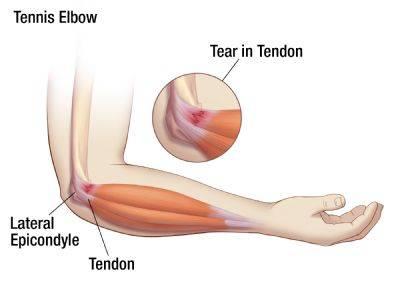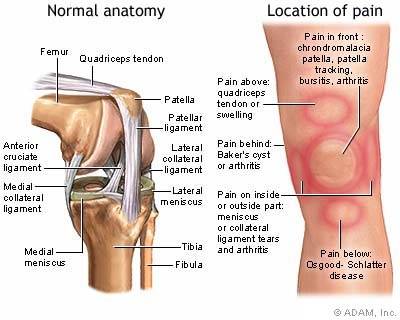Despite being considered a non-contact sport, over 275,000 baseball players visit the emergency room each year for baseball related injuries. As any baseball player knows, you don’t have to collide in the middle of the field like football or have another player swinging a stick at you like hockey to get injured playing your sport. In fact, you can get seriously injured playing baseball. What’s the difference between baseball and all those full-contact sports? You usually end up hurting yourself rather than someone else hurting you. The most common baseball injuries occur over time as the result of repeated stress to muscles and joints. Let’s take a look at four of the most common baseball injuries and how you can avoid them.
Common baseball injuries
1. Rotator cuff tear

Since 2000, there has been a fivefold increase in the number of serious shoulder and elbow injuries among youth baseball and softball players. Possibly the most common shoulder injury in this sport is a rotator cuff tear. Rotator cuff tears are most common in baseball pitchers due to stress put on their throwing arm from repeated movement but can occur in other players as well.
Your rotator cuff is a set of four muscles in your shoulder that allows the shoulder to rotate. Your shoulder can rotate into more positions than any joint in the human body thanks to your rotator cuff. Rotator cuff muscles are held together by bands of tendons and repetitive stress on those tendons can cause them to become inflamed and eventually tear. Tears usually occur over long periods of repeated movement and can cause pain and the inability to properly rotate your shoulder essentially putting you on the bench, especially if you’re a pitcher.
2. Tennis elbow
Tennis elbow, despite its confusing name, is not just for tennis players. It might be most common in tennis players but baseball players make a lot of the same motions as tennis players so it makes sense that this injury is prevalent in baseball as well.
Tennis elbow is essentially an inflammation or tear of the tendon that runs up the side of the arm next to the elbow and can happen to anyone who sings their elbow a lot. Makes sense that it would happen to baseball players, right? And, you guessed it, when tennis elbow occurs in baseball it’s most common in pitchers.
For more information on identifying tennis elbow, check out our Tennis Elbow vs. Golf Elbow: What’s the Difference? blog post.
3. Knee strain and tears
Injuries to the knees are most likely to happen to baseball players when running the bases. So this is most likely to happen to the stronger hitters who have to run the bases more often. Knee injuries in baseball players are usually caused by an impact against the knee or sudden twist of the joint that can rip the cartilage in the meniscus and cause a lot of pain.
Another common knee injury for baseball players is when the ligaments that hold the upper leg to the lower leg become strained or torn. These also occur due to sudden changes in speed and direction.
4. Head injuries
Regardless of whether it’s a pitch, hit or even just a throw coming towards you, if that ball hits you in the face, you run the risk of knocked out teeth, broken bones, a black eye or a concussion. Getting hit with a ball isn’t the only way you can sustain a head injury. Outfielders can bump into one another, runners can collide with catchers or a player might run into a wall running down a foul ball.
Prevention techniques
Although there is no way to assure 100% that a player won’t ever sustain one of these injuries, there are a few things that can be done to help prevent them. All of these prevention tactics are designed to keep your muscles warm and ready for strenuous activity.
Here are some of the most important prevention techniques for each type of injury:
Arm Injuries
- Always stretch your shoulder muscles properly before every practice or game.
- Warm up with a game of slow catch before pitching any fastballs or throwing long distances.
- Listen to your body. If your shoulder starts to throb or you feel any pain, tell your coach that you need to sit out the next few innings.
- Give your arm enough rest between games and follow recommended pitch limits for your age.
- Wear a jacket on your throwing arm between innings to keep the muscles warm.
Leg Injuries
- Always stretch your legs properly before every practice or game.
- Warm up your leg muscles with sprints, knee lifts, squats, lunges and other leg warm ups.
- Keep the blood flowing between innings by jogging to your position and lightly stretching.
Head Injuries
- Always wear a high quality helmet that fits properly when up to bat.
- Wear a mouthguard while at bat or even in the field.
- Be aware of your surroundings when chasing down a ball.
Baseball players in any age bracket run the risk of contracting one of the above types of injuries. With proper prevention, you can ensure that your muscles are properly prepared for the strain and intensity of a game and minimize your chances of injury.
One of the best ways to minimize your chances of injury is to engage in proper muscle recovery techniques. Our downloadable Day-to-Day Muscle Recovery will help you make sure you’re taking all the proper steps.





Leave A Comment